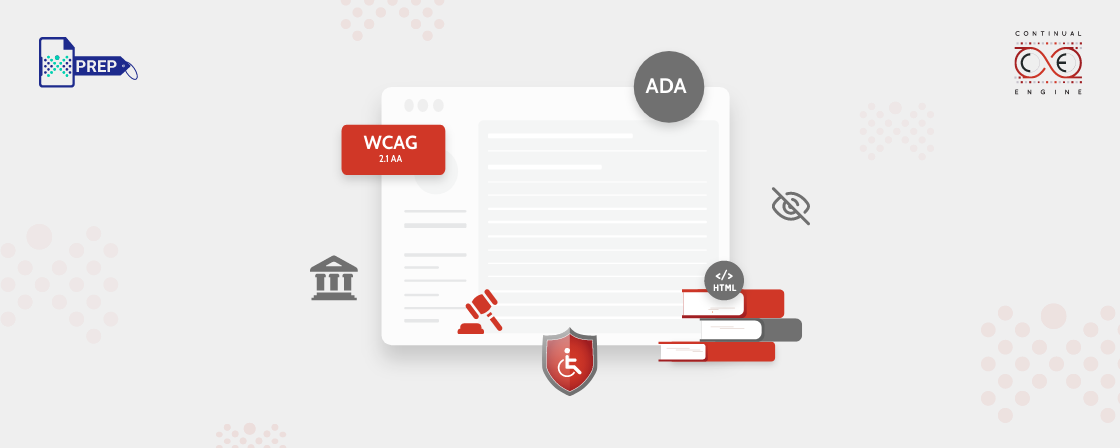Key Takeaways -
- Web accessibility laws require businesses and government agencies to ensure people with disabilities can access their websites.
- Web accessibility laws can benefit people with disabilities and non-disabled users.
- The Web Content Accessibility Guidelines (WCAG) are an international standard that makes digital content accessible to everyone.
- All public service businesses must comply with web accessibility standards.
Technology has made many services convenient. From shopping and banking to healthcare, you can do almost anything online. Unfortunately, not everyone gets equal access to these services. People with disabilities continue to face difficulties even with assistive technology.
Laws about web accessibility are required to strive toward a future with equal opportunities. This article provides an overview of what web accessibility laws entail, whom they apply and how to comply with website accessibility standards in the United States.
What Are Web Accessibility Laws?
Web accessibility refers to designing, coding and developing accessible websites and technologies for people with all disabilities to enjoy the same access as everyone else. However, many websites still have accessibility barriers, alienating at least 20% of the population.
Website accessibility laws are rules and guidelines that require businesses and government agencies to make their websites and other online information accessible to people with disabilities. In the U.S., it is governed by various state and federal laws, including The Americans with Disabilities Act (ADA), Section 508 of The Rehabilitation Act of 1973, and the WCAG.
Who Do Web Accessibility Laws Benefit?
The CDC (Center for Disease Control) reports that almost 61 million Americans have a disability that affects their day-to-day activities. Web accessibility laws ensure that anyone with disabilities has the same right of access as a person without a disability.
These disabilities can include but are not limited to,
- Vision impairments
- Auditory disabilities,
- Motor or dexterity impairments
- Cognitive and learning disabilities, and more.
While the laws focus on helping the differently-abled, it also benefits other users. Website accessibility improves user experience and can help older users, people with a slow Internet connection or low bandwidth, and even non-tech-savvy users.
Who Should Follow Web Accessibility Laws?
Although the ADA covers no specific guidelines for website accessibility, any public service business must accommodate its digital resources to people with disabilities.
The ADA, Section 504, and Section 508 of the Rehabilitation Act of 1973 apply to state and local governments. However, the Americans with Disabilities Act applies to private businesses under ADA Title 1 or ADA Title 3. These businesses are required to make both physical and digital adjustments. This includes:
- Under Title 1, any business with a minimum of 15 full-time employees operates for 20 or more weeks a year.
- Under Title 3, businesses that qualify as ‘public accommodations’, like hotels, banks, and public transport services.
How To Comply with U.S. Web Accessibility Standards?
In the United States, web accessibility for people with disabilities is overseen by the Americans with Disabilities Act (ADA). The act summarizes that all websites for public use must be easily accessible to people with disabilities. That is, anyone with a disability must be able to use your website with assistive technology. However, the ADA does not explain how to comply with U.S. web accessibility laws. There are no official criteria listed in ADA laws.
In this case, the Web Content Accessibility Guidelines (WCAG) are used to meet the requirements of an ADA-compliant website. An internationally recognized standard created by the World Wide Web Consortium (W3C), the WCAG is essential for any private or public organization. It is a set of technical guidelines that help make digital content accessible to everyone. By explaining how you can make your website, app or other digital properties accessible to people with various disabilities, these guidelines make it easier to review your online resources for accessibility barriers. If your business conforms with WCAG standards, it also complies with international and U.S. regulations.
WCAG 1.0, the first version, was released in 1999. It was followed by WCAG 2.0 in 2008, the current world standard. A new update called WCAG 2.1 was released in 2018, including more support for mobile web content.
The WCAG focus on making online content accessible to all, especially those with disabilities, with four criteria:
- Perceivable: Able to see and read the website.
- Operable: Easy to navigate across multiple browsers and mobile devices.
- Understandable: Easy to use.
- Robust: Able to adapt & integrate with Assistive Technology.
Not complying with U.S. web accessibility standards comes with the risk of legal action. If your differently-abled customers cannot access your website, your business could incur lawsuits, expensive penalties, and negative brand perception.
Final Thoughts
- Web accessibility laws strive to create a future with equal access.
- Web accessibility laws ensure that public digital communication is accessible to people with disabilities.
- These laws benefit people with disabilities and others, such as
- older people,
- people with slow Internet connections,
- and people who have trouble using technology.
- Web accessibility in the U.S. is governed by the Americans with Disabilities Act (ADA).
- The ADA laws show no official criteria for web accessibility. However, the Web Content Accessibility Guidelines (WCAG) is considered the internationally recognized standard to meet legal requirements.
- WCAG is a set of guidelines that help make digital content accessible to everyone.
- Failing to comply with U.S. web accessibility standards can incur lawsuits, monetary damage, and a bad reputation.
The internet provides global access to all kinds of information, but it does not mean everyone has equal access. That is why web accessibility laws aim to create an equal environment. While not explicitly stated, all public digital communication should be made accessible to people with disabilities to provide them with the same access and opportunities as others.
